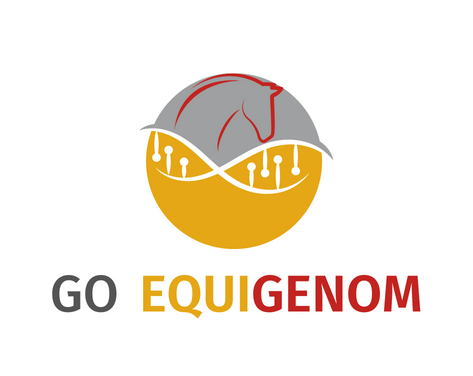
EQUIGENOM Operational Group: Development of a cost-effective MD chip for gene identification, disease diagnosis, detection of economically important traits, and genomic selection in PRE.
- Type Operational group
- Status Filled
- Execution 2022 -2025
- Assigned Budget 570.505,34 €
- Scope Supraautonómico
- Autonomous community Andalucía; Aragón; Madrid, Comunidad de
- Main source of financing CAP 2014-2020
- Project website https://goequigenom.com
Innovative application of an economical medium-density (MD) chip for the PRE that simultaneously allows the control of parentage, the early diagnosis of hereditary diseases (including those particular and specific to the PRE breed, such as cat neck among others) and chromosomal diseases, the detection of molecular markers related to traits of economic importance and the development of genomic selection in the PRE, which will be complemented by the development of a robust and easy-to-use digital tool, which integrates genetic information (from the improvement program) and/or genomic information (generated by the chip) of each animal, allowing its use in a quick and easy way to interpret for the farmer, centralizing all the information of the same animal in a single accessible digital file that helps them make improvement and crossbreeding decisions that allow higher and faster genetic progress and the detection and control of hereditary diseases, avoiding considerable economic expense as well as anticipating future problems and economic losses; with the consequent economic benefit of the farm.
- A reference population of 1,056 Purebred Spanish horses (667 males and 389 females) has been defined, selected for their high genetic influence and low level of relatedness, key to improving the accuracy of genetic assessments. They come from 710 stud farms, with an average age of 18 years for males and 21 for females, an average inbreeding of 6.74%, and an average co-ancestry of 4.55%. The stallions have an average of 58 offspring and the females 10, totaling 41,366 offspring distributed among more than 11,000 stud farms. Of these, 14,495 are in morphological and functional performance control, 769 are in dressage, 15,617 are genetically assessed for morphological suitability for dressage, and 1,053 are for dressage. In addition, 783 animals in the reference population have their own morphofunctional performance control, and 79 have been tested for dressage, which reinforces their value as a basis for genetic improvement.
The genomic profile of this population was obtained using the Axiom Equine Genotyping 670K array, generating 623,516 useful variants, evenly distributed across the 33 chromosome pairs. Of these, 188,851 are highly informative, providing a greater level of genomic information and thus accurately capturing the breed's genomic variability. - A panel of SNP markers was selected for parentage verification, chosen for their high reliability and ideal allele frequencies, ensuring greater accuracy in determining an animal's ancestry. Specifically, markers with the highest polymorphic information content (PIC) and the highest probability of exclusion (PE) in parentage testing were selected. Despite applying very strict criteria, 3,131 suitable markers were identified, distributed across all chromosomes.
- Genetic markers associated with diseases and traits of economic interest in the PRE (Pure Spanish Breed) have been selected. A total of 1,103 genetic markers related to simple inherited traits, such as genetic diseases, athletic performance, and coat color, have been selected. In addition, 167 markers associated with complex traits such as fertility or polygenic diseases (i.e., those influenced by multiple genes) have been included. These markers have been previously studied in both PRE horses and other breeds. Likewise, 308 markers have been added to detect chromosomal abnormalities previously observed in the PRE breed, providing an additional tool for monitoring the animals' genetic health.
All this information has been integrated into a medium-density (MD) chip (ARRAY) called EQUIGENE, which facilitates the application of genetics in PRE horse breeding and serves as a tool for marker-assisted selection (MAS). This will allow breeders to make more precise and timely decisions when selecting breeding stock, based on specific genetic information. - A panel of SNP markers was selected to enable high-density (HD) imputation using a medium-density chip. The panel includes 56,621 markers specifically selected for HD imputation. These markers exhibit low linkage disequilibrium (LD), i.e., low dependence among them, making them suitable for the imputation process.
With this panel, it is possible to predict between 246,385 and 483,772 markers with varying levels of confidence, demonstrating the method's accuracy. Even when very high accuracy (less than 1% error per marker) was required, it was possible to predict between 244,747 and 383,783 markers. - A medium-density (MD) chip (ARRAY) has been designed and manufactured, validated in the PRE breed. This low-cost chip, specifically designed for Purebred Spanish Horses (PRE), enables simultaneous verification of paternity, early diagnosis of hereditary diseases (including those specific to the PRE breed, such as "cat neck"), detection of chromosomal abnormalities, identification of molecular markers associated with economically important traits, and the development of genomic selection in PRE horses.
To this end, a total of 1,240 genetic markers were selected from scientific studies and international databases, focusing on economically relevant traits in horses, such as genetic diseases, behavior, athletic performance, and coat color. The chip includes 26,017 markers for high-density imputation and 15,705 for medium-density imputation, both with an efficiency exceeding 99%. In addition, 1,115 markers were selected for the equine Y chromosome (ECAY), distributed along the chromosome, and 1,000 mitochondrial markers were included, essential for maternal lineage studies. Likewise, the 376 markers from the ISAG-recommended panel were incorporated for kinship analysis.
In total, the chip contains 90,938 SNPs, covering a wide range of markers for various purposes, including 45,675 filler SNPs to ensure complete genomic coverage. - The selected reference population consists of 4,000 breeding animals with the greatest genetic influence in PRE horses, based on the number of offspring subjected to performance tests, and has been established for the implementation of genomic selection.
This population is composed of 22% males and 78% females, with average ages of 7.9 and 22.9 years, respectively. Fifty percent of the animals are 23 years old or younger, and 25% are between 1 and 3 years old. They come from 1,941 stallions, with an average of two animals per stallion, although 14 stallions had 20 or more individuals selected.
The average inbreeding coefficient is 7.55%, and the average relationship is 10.67%. Males have an average of 37.3 offspring, and females, 10.8. Regarding phenotypic records, 2,710 animals are under morphological performance control, 53 under dressage performance control, and 2,252 females under reproductive efficiency control. Regarding genetics, 2,828 animals have undergone functional conformation genetic evaluations, 1,603 dressage genetic evaluations, and 2,760 reproductive efficiency evaluations.
The reference population has been genotyped and the genotypes have been processed to generate a list of markers analyzed for parentage, coat color, monogenic and polygenic diseases.
Finally, high-density imputation was performed, obtaining highly reliable genotypic results based on the EQUIGENE chip genotypes. - Genomic evaluation models have been developed for the various selection criteria for the PRE breed, and these models have been validated. A validated protocol for genomic evaluation for the different selection criteria for the PRE breed has been designed using the single-step BLUP (ssBLUP) methodology, based on the model's suitability for each trait. In addition, the genetic progress of the PRE breed has been estimated.
Final models for genetic/genomic evaluation have been developed using the ssBLUP methodology for 34 morphological traits and 20 defects, 7 dressage traits and 3 reproductive efficiency traits.
The validation of the genomic evaluation models was performed by increasing reliability and estimating genetic progress, measured by improved reliability and reduced generation intervals. In morphology, reliability increased between 9.65% and 14.09%. In reproductive traits, the increase ranged from 1.80% to 3.96%, and in dressage traits, reliability increased by 3%. Regarding genetic progress, improvements in the response to selection were observed, with increases ranging from 2.11% to 8.82% in morphological traits. In reproductive traits, progress ranged from 1.61% to 5.88%, and in dressage, the response increased by 2.96%. - A digital tool, both web-based and as a mobile app, has been designed and developed for the Stud Book (LB). This digital platform has been promoted within the Spanish equine sector. It allows breeders to quickly and easily interpret the vast amount of genomic information generated by the SNP marker panel.
The platform centralizes and provides this information to breeders through a single, accessible profile containing all of their animal's genetic data. This will facilitate the rapid and widespread adoption of modern breeding techniques, resulting in faster and greater genetic progress, as well as the early detection of hereditary diseases that often entail significant economic costs—costs that could be avoided.
As a result, breeders will be able to anticipate and prevent future problems and financial losses, which will ultimately benefit the profitability of their operations. Furthermore, this digital tool can subsequently be applied to the equine sector of any breed, improving horse production and selection, enhancing the economic outlook for breeders and the sector as a whole, and boosting national and international marketing. - Communicate information about the working group and the project to industry and the general public. This has resulted in the creation of a project website, as well as the dissemination of project news and results through the group's website, the members' website, and various social media platforms to reach the entire target audience.
- Establish channels to disseminate the project's results to all end users (livestock farmers, ranchers, associations, researchers, veterinarians, laboratories, etc.). This result has been achieved in several ways. First, the operational group's dissemination materials have been designed, developed, and distributed at the various fairs attended by members of the operational group to promote the project. These include umbrellas and bags, among others. Second, scientific articles have been published in high-impact journals to showcase the project's most relevant results. Finally, various conferences, congresses, and fairs have been attended to deliver oral presentations outlining the project and the main results obtained, reaching industry professionals from different fields.
- Obtaining an economical medium density (MD) chip for the affiliation and genotyping of diseases and other characters of economic importance.
- Development of a genomic assessment system in the PRE.
- Development of a new digital tool accessible to farmers to enable them to interpret the results obtained from the chip.
- Selection of the reference population and genetic markers for diseases, Design and production of the medium-density chip and validation in the PRE.
- Development of genomic assessment models for the different PRE selection criteria.
- Design and development of the LG digital web tool and LG app, as well as its dissemination in the Spanish equine sector.
- Coordinator/entity name: Royal National Association of Purebred Spanish Horse Breeders (ANCCE)
- Coordinator/entity email: direccion@lgancce.com
- Federación española de Asociaciónes de criadores de caballos (FEACC)
- Real federación hípica española (RFHE)
- Sociedad española de equinotecnia
- Real asociación nacional de criadores de caballos de pura raza española (ANCCE)
- Real federación española de Asociaciónes de ganado selecto (RFEAGAS)
- Life technologies S.A
- Universidad de Sevilla
- Universidad de Córdoba (UCo)
- Esmedagro SL







